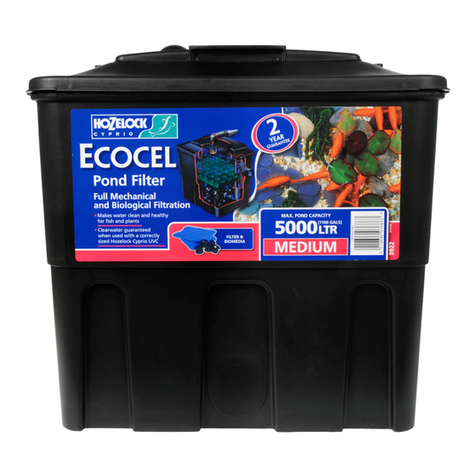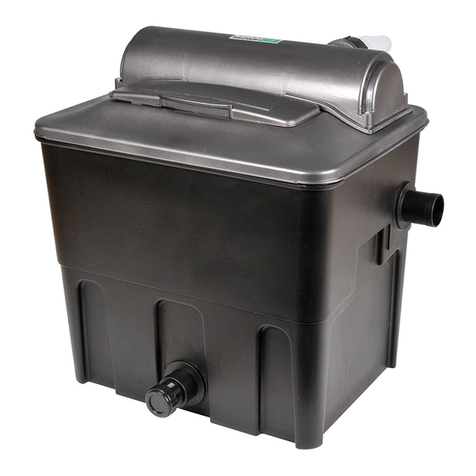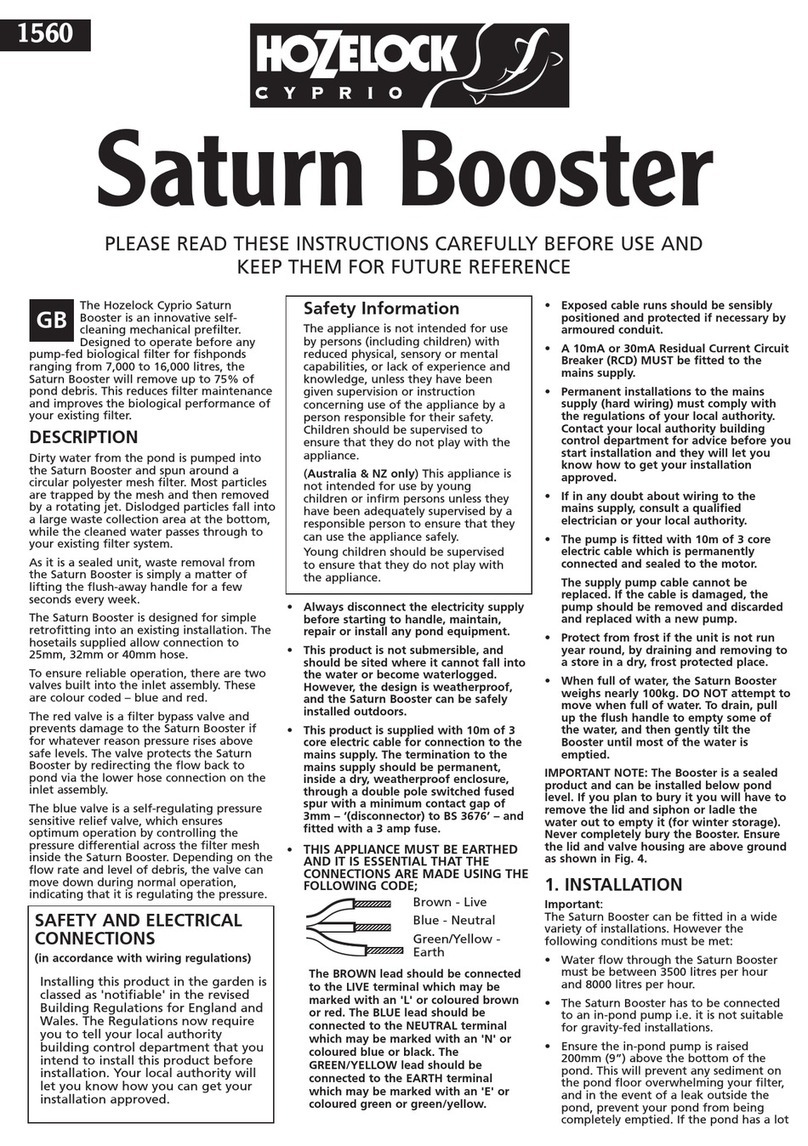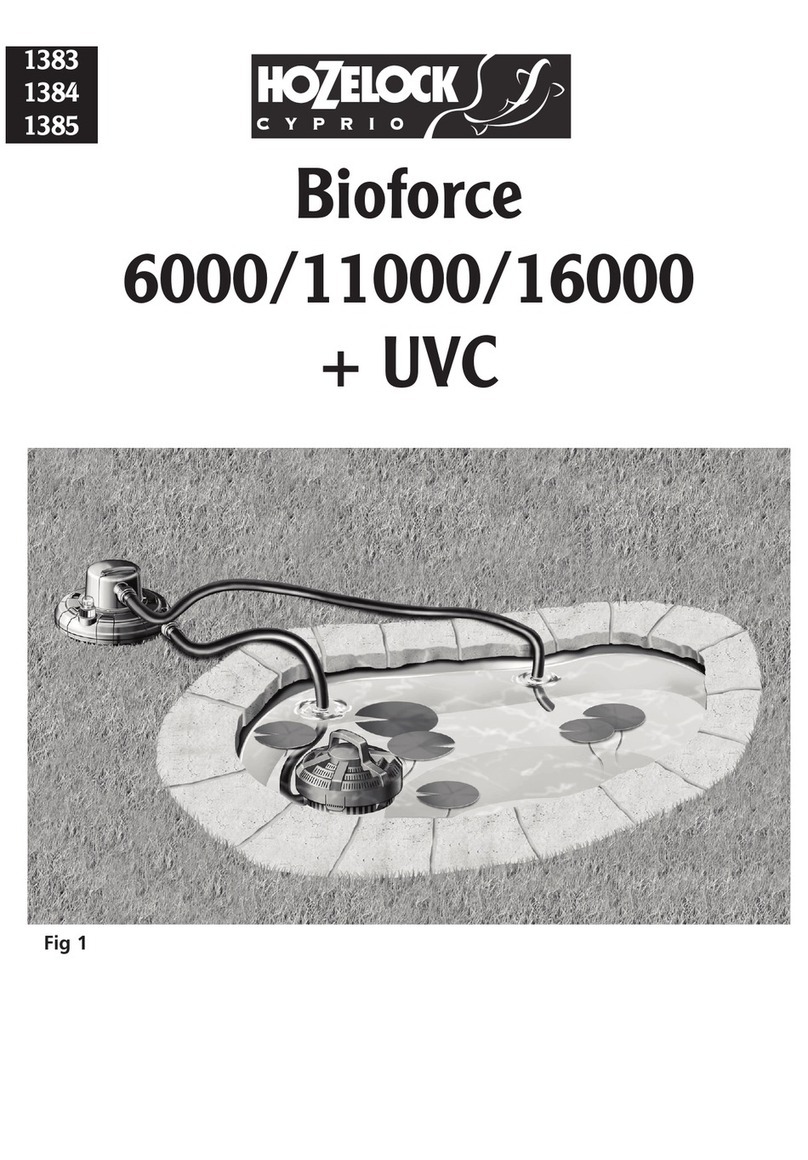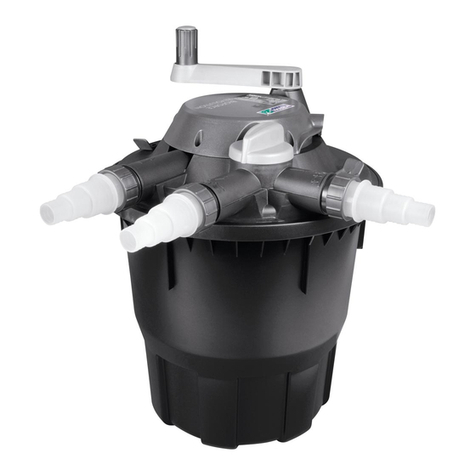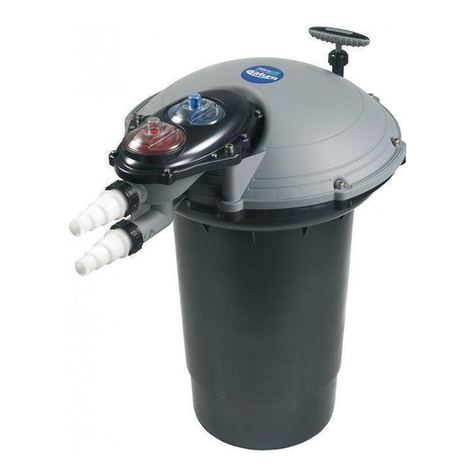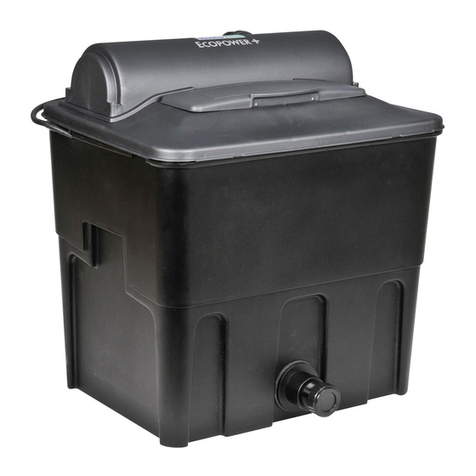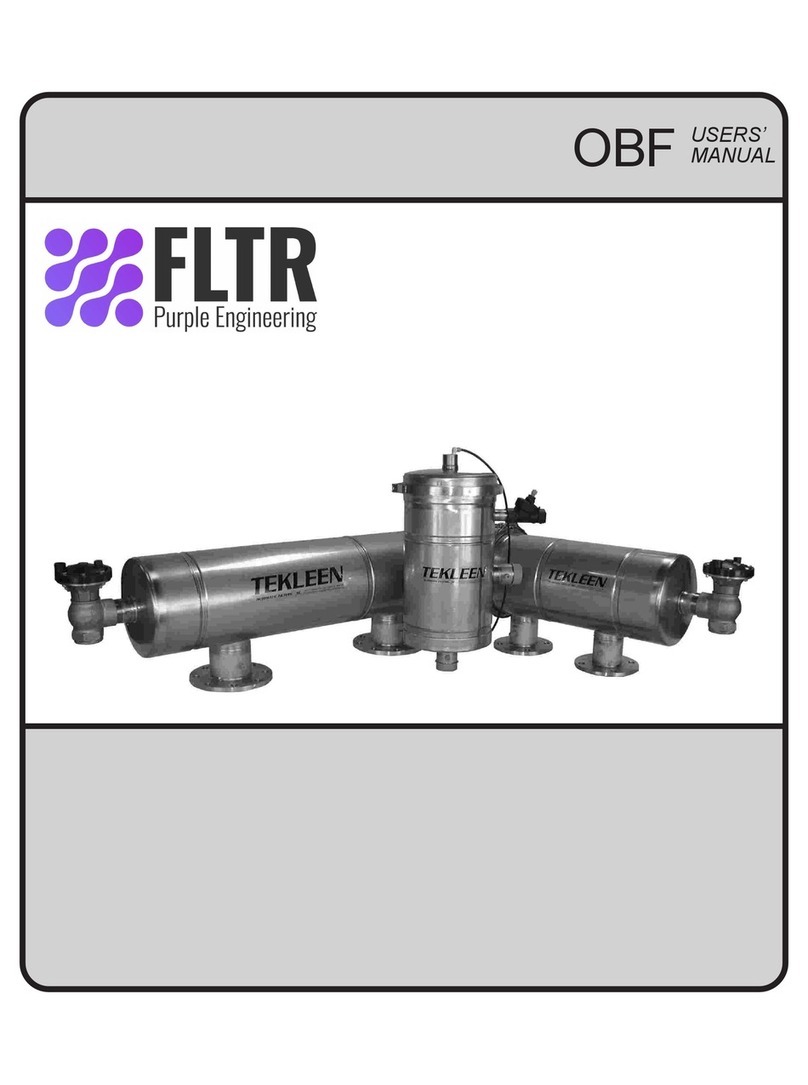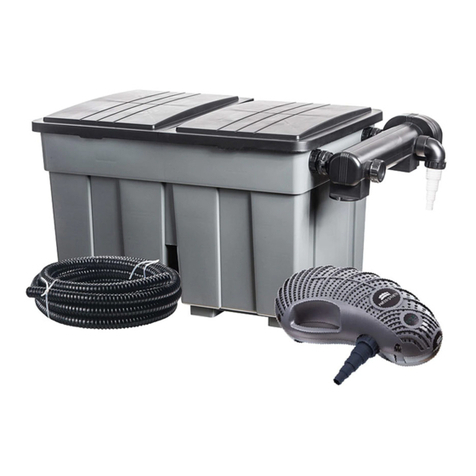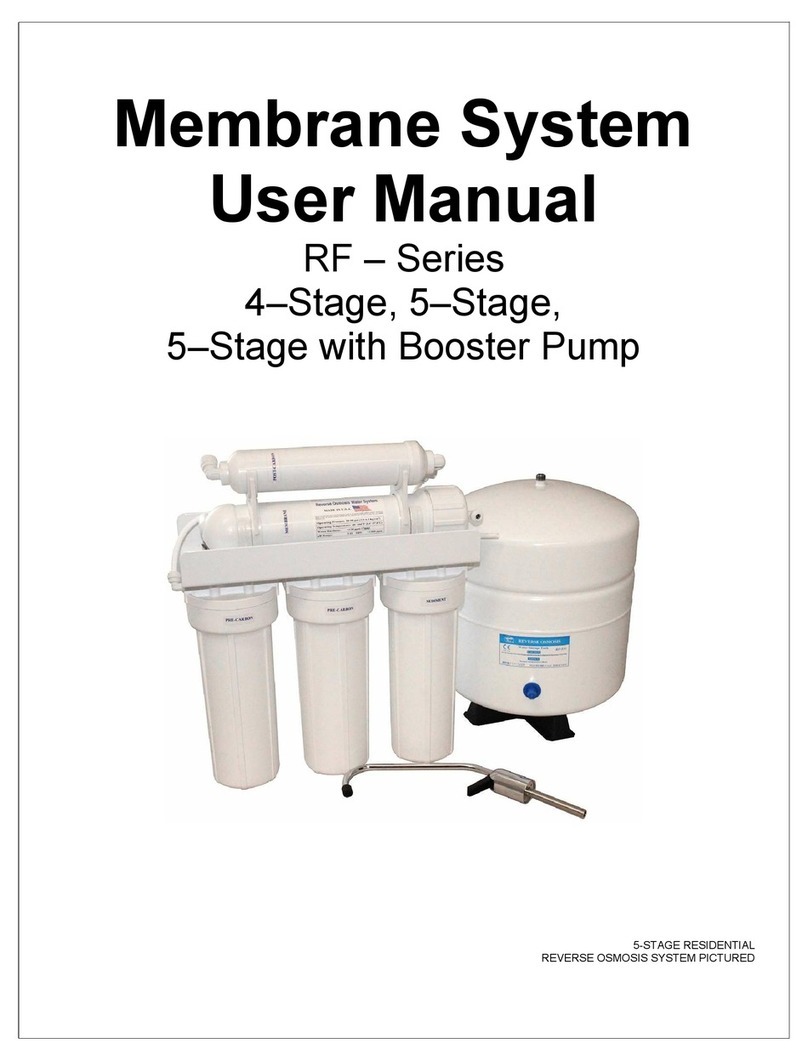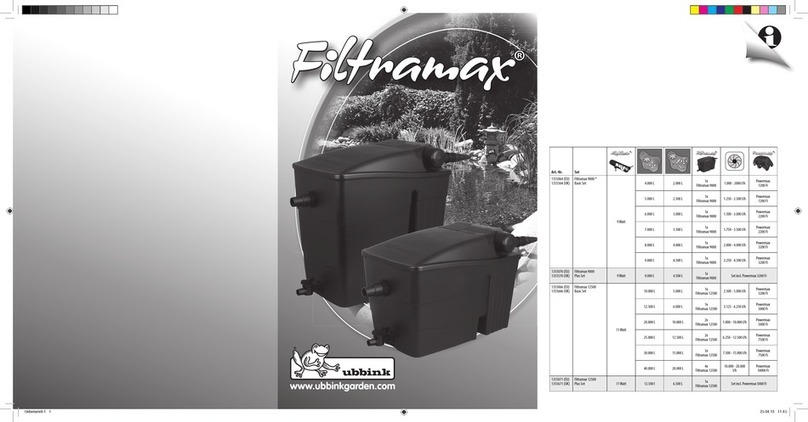and keep this hose run as short as
possible in order to minimise flow
restrictions.
2. LAMP INSTALLATION
AND REPLACEMENT
2.1 Lid removal
Undo the seven securing clips
and gently remove the lid (If
there is any difficulty, insert a
coin into the slot provided and
turn gently).
2.2 Remove the screw securing the
central tube to the lid and rotate
the tube anti-clockwise and pull
to release (See Fig 3).
2.3 Remove the quartz glass tube in a
similar way (See Fig 4).
2.4 With the lamp holder now
accessible, push the lamp into
position (See Fig 5).
2.5 Re-assemble the quartz tube into
position, ensuring the screw boss
is re-aligned and screw re-fitted.
Re-assemble the central tube to
the lid, twisting into position, and
refit the securing screw.
2.6 Lid fitting
Refit the lid, making sure the
seal is in position and free of dirt
and debris. Add a light coating
of silicone grease to the seal if
required to aid assembly. Re-
engage the seven securing clips,
ensuring all are firmly in place,
and retighten the viewing lens.
3. WIRING
3.1 IMPORTANT: This product is
designed to be connected to a
mains supply housed in a dry,
weatherproof enclosure.
3.2 WARNING: This appliance MUST
be earthed, and it is essential that
the connections are made using
the following code:
BROWN - live
BLUE - neutral
GREEN/YELLOW - earth
4. FLOW RATE
4.1 The entire pond volume should
pass through the Bioforce every 1
1/2 - 3 hours, the fastest flow rate
being recommended for Koi
ponds. Do not exceed the
maximum flow rate, as stated in
the Equipment Selection Chart
overleaf. The correct flow rate is
essential if you are to obtain clear
water. If the flow is excessive for
your installation it may be
necessary to adjust the flow to
achieve the 1 1/2 - 3 hour turnover
rate using a Hozelock Cyprio Flow
Control Hose Tap.
4.2 Small-diameter hose,
unnecessarily long hose runs and a
high pumping lift (‘head’) can all
considerably reduce a pump’s
output. We recommend choosing
a pump that will deliver the
required flow against full static lift
(= vertical distance between pond
surface and filter inlet), plus 0.6m
(2ft) to allow for friction losses in
hoses.
4.3 The objective of filtration is to
transfer waste material from the
pond into the filter, and so any
pump used as part of the package
should be capable of handling
solids. We recommend the
Hozelock Cyprio Titan filter pump,
specifically designed for ponds in
the size range covered by
Bioforce. The pump should be
positioned on the bottom in the
deepest part of the pond, as this is
where solids accumulate.
4.4 How to check your flow rate:
Take a container of a known
volume and time how long it
takes to fill (in seconds). Then
divide 3600 by the number of
seconds it takes to fill the
container, and multiply by the
volume (litres or gallons) of the
container. The result will be the
flow rate in gallons or litres per
hour
5. PERIODS OF OPERATION
5.1 Maintain filtration 24 hours a day
throughout the fish feeding
season (until water temperature
falls below 10ºC), but preferably
all year round. In the winter,
operating the pump and filter will
maintain a background level of
friendly bacteria in the Bioforce,
and will help prevent the pond
icing over in all but the severest
weather conditions. If the pump is
switched off for winter, the filter
media (foam and/or Kaldnes™
biomedia) must be thoroughly
washed before resuming filtration
in the spring, and your Bioforce
will need to be re-matured from
scratch (see ‘Maturation’, 7.1).
Never feed your fish when the
filter is not in use.
6. FISH STOCKING DENSITY
6.1 Under normal conditions and
feeding regime, the Bioforce
range will support up to 50cm per
1000 litres (10” of fish per 100
gallons) of pond capacity.
Introduce fish slowly over the first
few weeks, up to 20% of
maximum recommended level,
increasing this if you wish to 50%
after six months. The balance will
allow for fish growth.
7. MATURATION
7.1 Biological maturation means that
the filter has built up sufficient
nitrifying bacteria to convert
harmful fish and other organic
waste (ie Ammonia, Nitrite) into
harmless Nitrate. The process
normally takes 6-8 weeks, but is
dependent upon many factors
such as water temperature,
feeding rate and stocking density.
(It is recommended that you do
not switch your UVC on during
this period).
8. CLEANING YOUR
BIOFORCE
8.1 Bioforce filters deliver maximum
performance with minimum
maintenance. If the pond is very
dirty, the filter may need
cleaning every few day’s at first,
as it takes up waste matter very
quickly. Once the pond becomes
clearer, there will become less
waste to remove, so the filter
will need cleaning less often.
Pressurised filters are at their
most efficient when the foam
becomes partly blocked.
However, as blockage increases,
less water can flow through the
foam and cleaning becomes
necessary.
Note; Prolonged use of the filter
under ‘full’ conditions will result
in difficulty in cleaning and may
reduce the life of the foam discs.
8.2 IMPORTANT: The possibility of
dirty water being back siphoned
through the filter and into the
pond can be overcome by lifting
the submerged outlet pipe from
the water and above the height
of the filter lid before switching
off the pump. This will break any
potential siphon. In conjunction
with this, before any attempt is
made to remove the lid, the
viewing lens needs to be slightly
unscrewed to relieve any
additional potential siphon lock
in the system.
8.3 Thorough cleaning
Undo the seven securing clips
and gently remove the lid (If
there is any difficulty, insert a
coin into the slot provided and
turn gently). Gently remove the
foam from the filter vessel and
squeeze out the dirt. Using the
water in the filter, rinse out each
foam in turn using a sponge
action and squeeze the dirty
water outside the filter vessel.
Reposition the clean foam(s)-
ensuring they lie flat. It may help
to remove some of the water
from the vessel.
Refit the lid, making sure the
seal is in position and free of dirt
